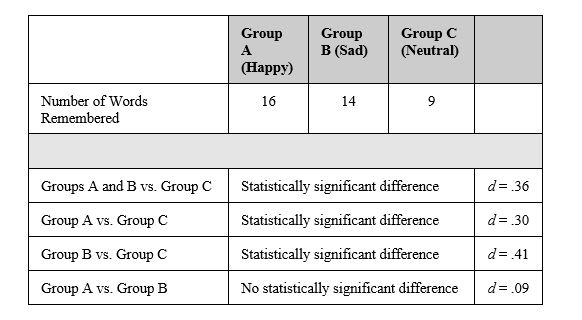RESEARCH STUDY 9.1
Dr. Lonsbary is a cognitive psychologist who is curious about how mood affects memory. She recruited 60 high school students and divided them into three groups. One group (A) listened to a 5-minute piece of music intended to make them feel happy (a song entitled "Don't Worry, Be Happy") . One group (B) listened to a 5-minute piece of music intended to make them feel sad (a song entitled "Alone Again") . One group (C) listened to no music and instead was asked to sit quietly for 5 minutes (thought to make them feel neutral) .
When a participant would come to her laboratory, she would greet the participant and then ask him or her to draw a card. If the participant drew a 1, 2, or 3, he or she was assigned to Group A. If the participant drew a 4, 5, or 6, he or she was assigned to Group B. If a participant drew a 7, 8, or 9, he or she was assigned to Group C. The participants were then given a CD to listen to based on their group assignment. The CD contained the song selection or 5 minutes of silence. There were no identifying marks on the CD indicating what was contained on the disc. They were then escorted into a different room, where they were greeted by a research assistant who conducted the experiment. The research assistant sat the participants in front of a computer screen and told them that a list of 25 words would be displayed on the screen. They were instructed to put the CD in the computer, put on the headphones, and listen to the CD while trying to memorize the list of words.
When 5 minutes had passed, the screen displayed a question asking them whether they felt happy, sad, or neutral. After the participant responded, a new screen was displayed asking them to type in all the words they could remember from the list of 25 words. All participants were given 3 minutes to type the words they remembered. In addition, all participants were given the same list of 25 words to remember. Afterward, the participant was thanked and dismissed. In response to the mood question, a majority of Group A participants said they were happy, a majority of Group B participants said they were sad, and a majority of Group C participants said they were neutral in their mood. Dr. Lonsbary found the following results in response to the number of words remembered.

-Refer to Research Study 9.1 above to answer the following question. Which of the following provides information about the statistical validity of Dr.Lonsbary's study?
Definitions:
Social Structure
The patterned social arrangements in society that are both emergent from and determinant of the actions of individuals and groups.
Audience Interpretation
Audience interpretation refers to the process by which viewers or listeners understand and make meaning of media content, which can vary significantly across different individuals and cultures.
Women Watching Television
A demographic focus that examines how women interact with television content, including viewing habits and preferences.
Polysemy
The phenomenon where a word, phrase, or symbol can have multiple meanings or interpretations.
Q13: The westernmost and largest of the five
Q14: _ is a subdiscipline of psychology that
Q18: Dr.Deveraux has conducted a study that has
Q19: Refer to Research Study 9.1 above to
Q24: Refer to Research Study 11.2 above to
Q26: Refer to Research Study 9.2 above to
Q31: Which of the following is another term
Q37: Which city is not located in the
Q83: Which of the following is one of
Q90: _ is the most Asianized metropolis in